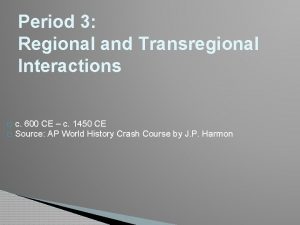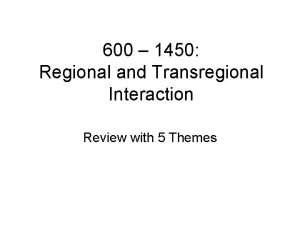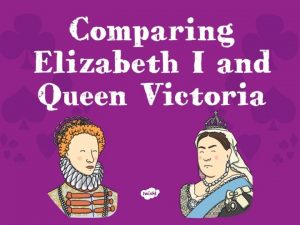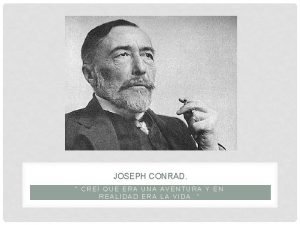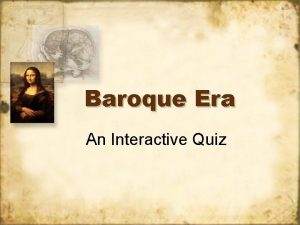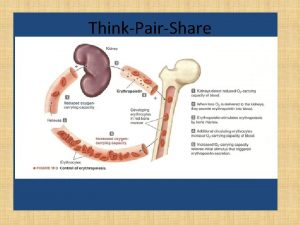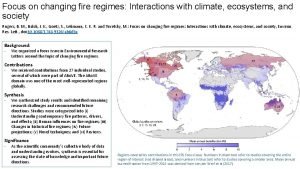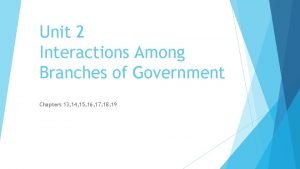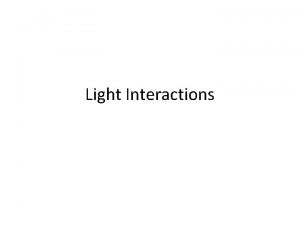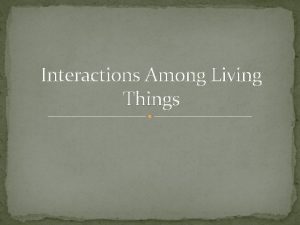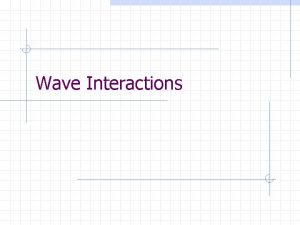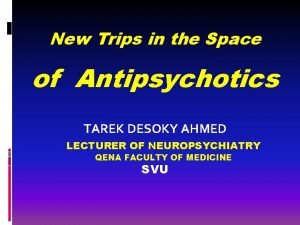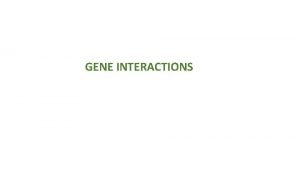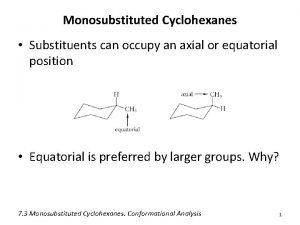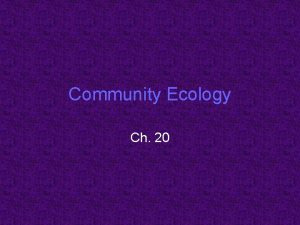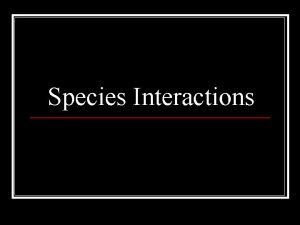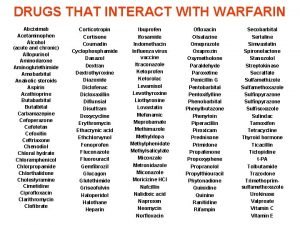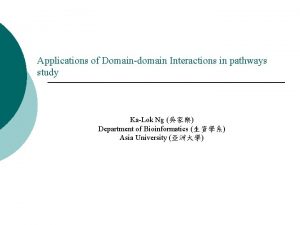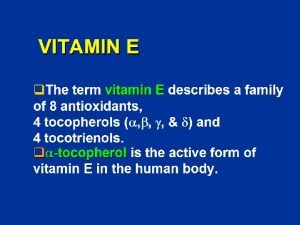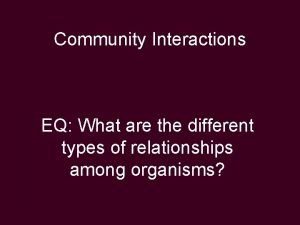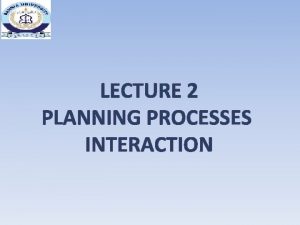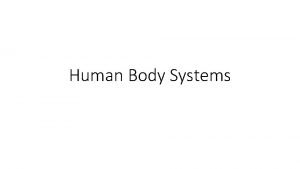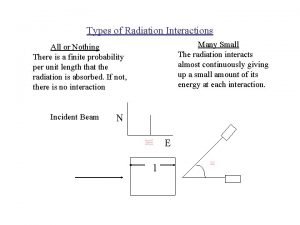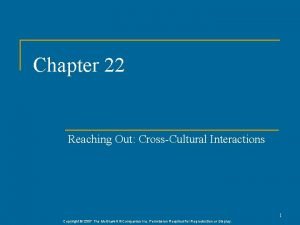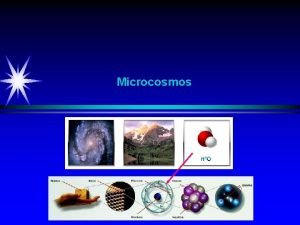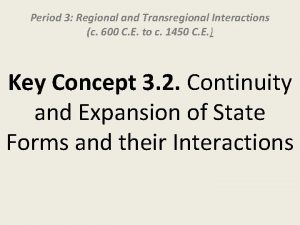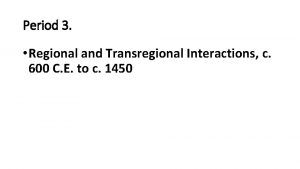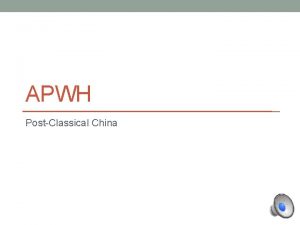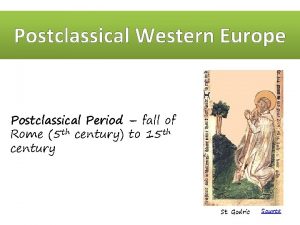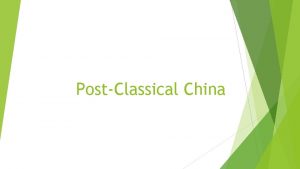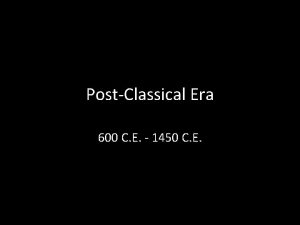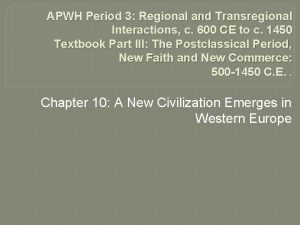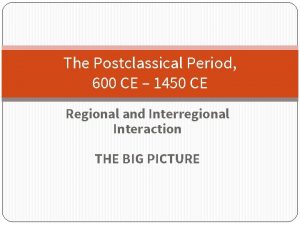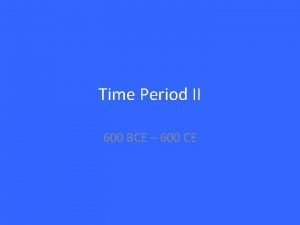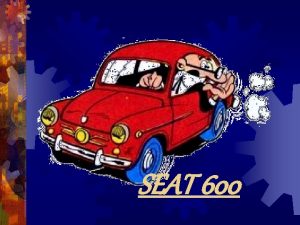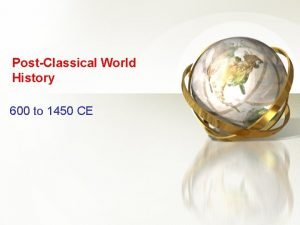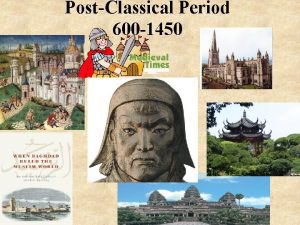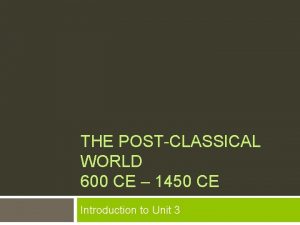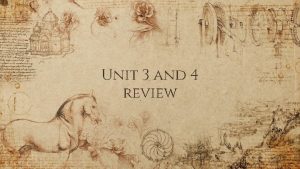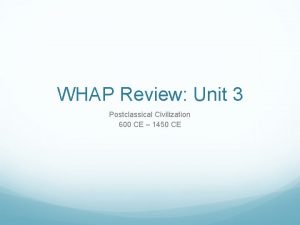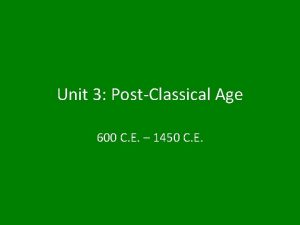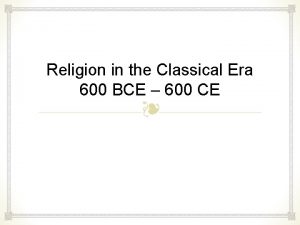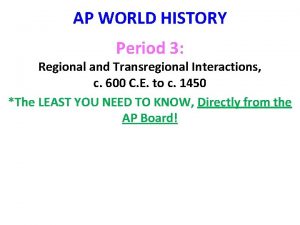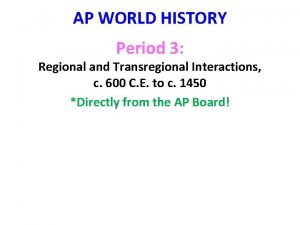The Postclassical Era Regional Transregional Interactions 600 CE























































































- Slides: 87

The Postclassical Era – Regional & Transregional Interactions 600 CE to 1450 CE

What were the Postclassical Era (Middle Ages)? ** Periodization Activity ** • Periodization => Q: Why 600 CE? Why 1450 CE? • In general, it is a time period (~600 CE to 1450 CE) between the Classical and Modern ages (European) § Historian Leonardo Bruni 1 st developed the idea of dividing history into Classical, Medieval and modern periods -- Based on the writings of Petrarch that European culture had stagnated & drifted into a “Dark” time after the fall of Rome -- Enlightenment and Reformation scholars agreed and idealized the classical period as the time when Christianity 1 st developed § Its name (Medieval) denotes some type of deficiency or primitive quality to it, yet there were many positive developments -- European Universities (Oxford, Cambridge) were begun -- Gunpowder, the magnetic compass, moveable type printing and the Dhow ship were all popularized -- In Africa, Mesoamerica cultural expression reached its zenith in the civilizations of Mali, Ghana, Zimbabwe and the Aztecs & Incas -- In the Middle East Islam developed and led to a cultural flowering and rapid political & economic expansion -- Pastoral peoples (i. e. Mongols, Turls) reached the height of power also

Postclassical Era States and Empires • Politically, Middle Age states & empires can be divided into a few categories. . . #1: Reconstituted States => states that had existed before, but were now reinvented with new ideas and/or strategies § Byzantine Empire, Sui/Tang/Song China, Holy Roman Empire #2: Islamic states & Empires => Islam became a unifying force in the ME; empires expanded & traders/missionaries spread the faith to other areas § Abbasid Empire, Ghana, Mali, Delhi Sultanate, Andalusia #3: Feudal States => feudalism predominated in Europe and Japan § Kingdom of Charlemagne and Japanese shogunates #4: Mesoamerican Empires => civilization reached a zenith w/ the rise of empires § Aztec and Incan empires #5: City States => city states were used for religious and trade purposes § Italian city states (i. e. Venice), Mayan city states (i. e. Tikal) and Swahili city states (i. e. Kilwa) #6: Pastoral Empires => pastoral peoples reached height of power § Mongol Empire, Viking raiders, Seljuk Turks ** All states and empires combined traditional sources of power (i. e. elites, patriarchy, religion) w/ new innovations (i. e. tributary systems)**

The Rise of Islam • The Arabian peninsula prior to Islam was a divided place inhabited by Bedouin tribes => each ruled by a ______ & tribal council § Religion was polytheistic w/ a supreme God Allah presiding over a pantheon of spirits that inhabited natural objects (trees, rivers) -- Allah was said to inhabit a sacred stone (each town had one) -- No priests; religion a communal experience § Economy was based on trade caravans using camels => due to Byzantines & Sassanid Empire wars trade came through Yemen -- Growing tension between Bedouin traders and merchant elites • __________believed that while meditating in the desert he was given the final revelation of GOD (Allah) like Abraham and Jesus before him § Muhammad never claimed divinity (_______) § Islam has no central religious authority or leader; ____ = scholars § Revelations were written down in the _________=> 114 suras that were organized by committee after Muhammad’s death -- Quran is a sacred book, contains guidelines for living and also discusses governmental organization -- ______is also a holy book, collection of Muhammad’s sayings => used to interpret Quran and supplement its teachings

The Koran and Hadith The earliest versions of the Quran do not contain marks used in Arabic to denote meaning, thus the true meaning of certain sections is constantly debated => some Hadith sayings were not written down for centuries after Muhammad’s death

Main Tenets of Islam • The goal of a Muslim is to reach paradise (luxurious garden) through submission to the will of Allah => i. e. follow__________ #1: Believe that there is one God (Allah) & Muhammad is his prophet (______________) #2: _____________towards Mecca #3: Fasting during month of _______(sunrise to sunset) #4: _____=> pilgrimage to Mecca (walk around Ka’aba) once during life #5: _______=> giving alms to the poor (2. 5% per year) • Islamic belief is also seen as a way of life => _______law code drawn up to regulate behavior § Muslims forbidden to gamble, drink alcohol or lie § Sexuality is strictly restricted => contact between unmarried frowned upon, marriages are to be arraigned by parents -- Women should cover themselves to avoid “tempting” men -- Polygyny is permitted but Muhammad limited wives to four • Islam is clearly part of the ME religious tradition that includes Christianity, Judaism and Zoroastrianism § Bible is a holy book in Islam and Jews and Christians are called “people of the book” => God spoke to them 1 st & made final revelation to Muhammad § Muslims tolerate other “people of the book” in most early civilizations § Like Zoroaster, Muhammad wandered in the desert & received revelations

The Ka’aba in Mecca Inside the Ka’aba container is a black meteorite that fell to earth and is seen as a divine object => 6 million Muslims make the Hajj each year

Muslim prayer -- Salah The Salah has certain steps and characteristics => removing shoes, bowing down and prostrating, chants are common; Muslims are called to prayer 5 times a day in many countries from minarets

The Spread of Islam • After Muhammad’s death in 632 his closest followers elected Abu Bakr (Muhammad’s father in law) to succeed him as caliph (ruler) § Caliph was considered a political as well as religious office (imam) § Many followers believed that Ali, Muhammad’s 1 st cousin and husband to his 1 st daughter was the rightful heir o Led to the birth of ______(“Party of Ali) & ______ (“people of tradition & community) split in Islam -- _____believe that only family of Ali should rule as caliphs -- _______believe the community elects own leadership • Despite the controversy Islam spread very quickly throughout Arabia and the Eurasian world in variety of ways (see graph). . . #1: ______________ • Muslim armies defeated the weakened Sassanid & Byzantium forces in Persia, Syria and Egypt => expanded to nomadic tribes of C. Asia (Turks § Formed the _________=> expanded into Persia further, conquered Berbers in N. Africa and the Visigoths in Spain § How? => use of mobile cavalry, devotion to cause & belief that those who die in battle ascend to glories of heaven • In 750 the Umayyads were overthrown due to decadence => caliph swimming in a pool of wine and becoming drunk; dozens of wives, etc. .

The Expansion of Islamic Rule

Abbasid Caliphate • The ____________took its place (new style) § ____ (religious & political leader) was the ruler who administered the autocratic govt system & was seen as Muhammad’s heir -- The Caliph relied on a vizier (PM) to lead the council of bureaucrats who collected taxes and administered the army § Abbasids established their capital at ______=> became a cosmopolitan cultural center (Greeks, Persians, Arabs, Jews) -- Compiled religious tracts (Hadith), translated Greek learning & wrote Arabic poetry, songs and texts (1001 Nights) -- Led to _______________from China to Europe => paper (China), zero (India); Indian dhow ship & lateen sail § Abbasid rulers were very influenced by _____customs and rituals -- Persians occupied many high level admin positions -- Abbasid rulers sat on golden thrones encrusted w/ jewels in large audience halls of petitioners (executioner next to throne) -- Adopt and administer a tribute system where outlying areas pay taxes to Baghdad (head tax on all non-Muslims; taxes on trade)

The Abbasid Caliphate

Harun al Rashid & Caliphate Chinese travelers described the court of Harun-al-Rashid, “The king wears a turban of silk brocade and foreign cotton stuff. On each new and full moon he puts on an eight-sided flat-topped headdress of pure gold, set with the most precious jewels in the world. His robe is of silk brocade and is bound around him with a jade girdle. . . The king’s throne is set with pearls and precious stones, and As the capital moved East to Baghdad, the steps of the throne are Caliphate came under extensive Persian influence => decadent palaces, jeweled thrones, covered with pure gold. ” harems, etc….

Fracturing of the Caliphate • After 850 or 900 CE, the Abbasid caliphate weakened and the Islamic concept of “caliph” was fractured between many rival states. . . § Why fall of Abbasids? -- _________=> caravans traveled 20 miles/day, couriers 100 miles/day (hard to communicate and respond to crises) -- ______________=> snowfall in Baghdad killed date trees, rivers & canals became silted due to overpopulation -- Decadence and decline => Abbasid rulers became focused on wealth and extravagance (wine, harems, homosexuality) -- ____________=> Mamluks (Turkish slaves/soldiers) were widely used and revolted to form the Seljuk dynasty by 1060 • By 1100 the Caliphate had fractured into many parts § Shi’ite Fatimid Dynasty in Egypt (Cairo); Seljuk Turkish dynasty in Mesopotamia & Andalusian Muslim kingdoms in Spain (Cordoba) § Madrasas (Islamic religious universities) and Imams preserve

The Fracturing of the Muslim Caliphate

Spread of Islam #2: _________________ • Tradition of raiding and trading led many leaders to pledge support to Muhammad & caliphs (protection from raids & freedom to trade) • In Abbasid caliphate (and other Muslim countries) highest classes were judges, officials and merchants => Muhammad started as a merchant § Baghdad capital located at the intersection of trade routes => overland Silk Road from East and Indian Ocean trade up Tigris § __________were used by Muslims in ME to trade w/ Chinese, African, Indian and European merchants -- Muslims traded carpets, spices, glass, textiles for silk & porcelain (China), jewels and spices (India) & ivory, slaves, salt and gold (Africa) • During Abbasid rule, non-Arab & Arab Muslims were treated as equals => gave rise to greater conversion rates among conquered populations § Benefits of conversion = freedom from head tax (______) , greater opportunity for education, access to govt positions, adv. in trade § Merchants who converted to Islam were favored over non-Muslims • __________________were key to the intl. spread of Islam § Diasporic merchant communities established along the Indian Ocean & Saharan trade routes => Swahili City states, Malacca, Ghana & Mali -- Islam represented commercial success and high social status => many elites converted (filtered down in many cases)

Middle Eastern trade bazaar A bazaar is basically what we would call a marketplace => goods are exchanged and merchants of many different nationalities are gathered

Muslim Diasporic Communities in the Indian Ocean Muslim merchants on the Indian Ocean and Saharan trade routes established Muslim communities that gradually became vehicles for conversion => locals were attracted to religions, focus on equality, connection w/ trade, etc….

Spread of Islam #3: _________________ • Sufism was an Islamic movement that started in the 750 as a reaction against the excesses of elites in the Umayyad & Abbasid dynasties § Sufis attempt to get closer to Allah in this life by living lives of ______ and following Islamic law perfectly -- Sufi followers must learn under a teacher (mystic) who gains authority in an unbroken line back to Mohammad (via Ali) • Although their intent was not missionary per se, Sufi’s attracted followers and converts throughout Eurasia § Many were attracted by purity of worship (i. e. Buddhism) § Sufi missionaries spread out across Eurasia => West Africa, India, Malacca, Central Asia & won converts via example

Religious Conversion in Different Locations #1: ________=> Islam spread by Muslin traders across the Sahara • Peaceful and voluntary acceptance of Islam => mainly occurred in Urban centers among the elite or merchants (i. e. Mansa Musa) § Many W. African cities became centers of Islamic religious and intellectual study (adopted Arabic language) => i. e. Timbuktu -- 150 Qur'anic schools, several madrasas, huge mosques #2: ________=> conquered by Arabic Berbers in 700 and became a vibrant Islamic civilization (capital = Cordoba; #1 city in world by 1000 CE) § Religious toleration led to harmony & cooperation between Muslim, Jewish and Christian scholars & artisans (mixed civilization) § Astronomy, medicine, arts and architecture all flourished § Declined in 11 th century when toleration ended and constant warfare ensued between Christian and Islamic kingdoms #3: ________=> Islam imported through Turkish tribes from C. Asia § Initially very violent => destruction of Hindu and Buddhist temples (led to series of Muslim led governments; Delhi Sultanate, etc…) § Islam never became dominant due to cultural boundaries (i. e. monotheistic, lack of icons and statues, focus on equality of all believers, sexual modesty)

Postclassical Era States and Empires • During the postclassical era there was considerable continuity in statecraft, but also great changes and diversity in how societies organized civilization #1: Reconstituted States => some societies like the Chinese and Byzantines reorganized old models and applied new techniques to meet needs ______________=> began as the Eastern Roman Empire • Emperor Justinian attempted to revive the Roman Empire in scope (by conquest) & ideology (by compiling its law in the___________) § Failed & empire reborn as the Byzantine Empire (600 - 1453) • Byzantine Empire combined traditional power w/ new innovations § Traditional sources of power 1. Roman authority => style themselves as heir of Rome -- Use Roman legal code (_________) 2. Ritual & Ceremony => elaborate religious centered ceremonies (i. e. procession of all govt officials opening palace each day) 3. Military power => Byzantines were basically a military state for centuries(threats from Islamic Turks, Germanic kingdoms) -- _____________were highest in world; use of “Greek Fire”

Map of Byzantine Empire The Emperor Justinian brought back the glory of the old Roman Empire for a short time via administrative reforms and conquest => these conquests drained the empire of resources and were short lived (by 605 Italy was lost)

Byzantine Empire (ca 1000 CE)

Postclassical Era States & Empires – Byzantine Empire § New Innovations v Byzantines smuggled silkworms from China and started a silk industry (state monopoly which raised huge revenues) v Byzantines also sought to separate themselves from Latin Christianity by promoting __________(Greek language) -- Used ______faith as a method of political control => reason for expansion into Eastern Europe & beyond -- Use of Christianity as a unifying force => emperors put $$ into church construction & iconography (i. e. Haga Sophia) -- Greek Orthodox ________= leader of Orthodox church -- Series of schisms (icons, Nicene Creed wording) resulted in excommunication of Pope Leo IX by Patriarch Michael in 1054 -- Byzantines desired to spread Orthodox Christianity => led to conversion of Kievian Russia to Orthodox Christianity in 988

Hagia Sophia – Byzantine Architecture The Hagia Sophia was the most impressive cathedral in the world until the Vatican constructed the Sistine Chapel during the Renaissance => it was the site of many ceremonies meant to increase the prestige of Orthodox Christianity

The Iconoclasm debate in Byzantium Icon = image of Jesus, saint or religious image Icon were popular and worn by many Christians due primarily to illiteracy; Byzantines banned icon production during the 9 th century as a means of separating themselves from Roman Christianity (pagan & worshipping images)

Postclassical Era States and Empires Sui/Tang/Song China => after the fall of the Han dynasty China entered a period of 4 centuries of disunity • In 581, the Sui Dynasty reunified China under one Emperor at Chang’an • The Sui, Tang & Song dynasties combined traditional power w/ new innovations Traditional Power 1. Religion/ideology => by the Song Dynasty _________reemerged after Sui & Tang emperors endorsed Buddhism § _____________was an attempt to combine traditional Confucian principles w/ metaphysical ideas of Daoism and Buddhism -- World is real => fulfillment comes from embracing world -- World exists as two separate spheres => material world and spiritual world (____________, like the Dao) -- Supreme Ultimate governed by a set of conflicting principles (__ ____) and goal was to transcend material world via self cultivation -- Average Chinese not really effected by new changes (still worshipped household deities) but Buddhism did bring a belief in reincarnation

Neo Confucian Scholars Zhu Xi was the founder of Neo-Confucianism and holds a reverence close to Confucius himself => believed the central focus of life should be the investigation of things and improvement of self (path to Supreme Ultimate)

Postclassical Era States and Empires 2. Landed elites => during the Song dynasty the landed gentry emerged as the pre-eminent class in Chinese society -- Controlled most land in rural areas & received education in Confucian classics -- Due to superior knowledge, 50% of bureaucrats were elites 3. _________=> continued during Tang & Song dynasties -- Only males allowed to take Civil Service Exam -- Practice of _________is cultivated to attract wealthy husbands => sign of submissiveness and self discipline § New innovations 1. During the Sui and Tang dynasties _______was established as state religion due to popularity among people -- Monasteries built, _________used in Civil service exam, Buddhist art created and patronized -- Later Tang dynasty persecuted Buddhists and destroyed temples as fear of foreigners increased due to border problems

Song Civil Service Examinations • Held every year at 3 levels => provincial, district & imperial -- Farther you went higher your govt. position • Chinese academy at Chang’an had 30, 000 students by 1 st century BCE • Young boys would study Confucian classics, which were the subject of the exam, for years -- Emphasized obeying parents, respecting elders, good morals, respect for tradition, respect for others and peace Q: How would China benefit from basing government position and leadership on examinations? List three benefits.

Chinese Footbinding

Postclassical Era States and Empires 2. _____taxation system used to raise revenues under the Tang -- Attempted to reduce power of wealthy landowners by granting land for life to farmers in return for a tax payment & 3 weeks labor -- Song also tried to do the same by taxing land progressively 3. _________=> Tang and Song instituted tributary relationships with Korean peninsula as well as states in SE Asia -- ________________all paid tribute at one time -- Tribute states benefitted by gaining recognition from China and access to trade with Chinese markets

Sui (581 -618) & Tang (618 -907) Dynasties

Song Dynasty (960 -1279) The Song Dynasty was constantly threatened by nomadic groups => the Jin conquered the Northern section in 1126 and the Mongols conquered the Southern Song in 1279

Feudalism in Europe & Japan #2: Feudal States in Europe and Japan • _______= decentralized political organization where local lords control land & military power & give them out in exchange for service European Feudalism • After the fall of the Rome in 476 Europe was a cluster of small Germanic kingdoms for 400 years § All Christian kingdoms & melded German traditions with Christianity => use of _____(payment to family for wrongdoing) & ordeals § There were attempts at unity in Europe during the Middle Ages #1: ___________(ca 800 CE)=> broken up after death #2: ________(ca 1000 CE) => Otto I of Saxony and others tried to institute an Empire encompassing Germany and Italy -- Failed due to internal conflicts & church squabbles and led to both areas being ruled by small independent city states • Feudalism developed as a social, political & economic system to fill the void and offer protection from various raids (Vikings, Muslims, etc. . ) ** GW: Feudalism in Europe and Japan **

Charlemagne or Charles the great It was a Germanic practice to divide territory between sons at the time of the fathers death – reason Germanic kingdoms couldn’t maintain stability

Holy Roman Empire was actually more a collection of independent city states and principalities => no direct central authority

European Knights of Middle Ages Middle Age Knights were expected to follow the Code of Chivalry => bravery in battle, dedication in training, service to all (lord, less fortunate) Knight warfare dominated Europe for over 500 years (800 -1300 CE) => knights were responsible for training and outfitting themselves (expensive and time consuming) => expected to have a sword, lance, horse (rode w/ stirrups borrowed from Central Asian nomadic groups)

Manorialism diagram Manoralism and fief holding dominated Europe for 500 years (800 -1300 CE) and became increasingly complex => larger fiefs were subdivided and a series of requirements was made for all classes

Feudalism & Manoralism Major duties of each class: • Lords => provide fiefs for vassals and protection/support in court • Vassals => provide military service or knights for lord (~ 40 days/year) -- Provide land & protection to serfs • Knights => give military service to Lord/vassal; train and outfit themselves -- Large horse (carry man & armor); sword, lance • Serfs (60% of population) => give service to lord (3 days/week); pay rents in form of % of crops

Feudalism Hierarchy

Feudalism in Europe & Japan § Traditional sources of power (continuity) 1. Patriarchy => feudal society remained very patriarchal -- Division of labor w/ men in public sphere (farm land, tradesmen) & women in domestic (kids, food, etc…) 2. Military power => lords used ______to maintain military control 3. Use of religion => MA kings like Charlemagne & Otto I were crowned by the ____and sought to convey_____________ 4. Land owning elites => vassals who owned fiefs and managed land § New Innovations 1. _____=> serfs forced to work for lords 3 days/week (bound to land) and pay % of crops to lord in exchange for land 2. Support of monasteries & growing power of Catholic church => o ______________(nuns) granted land & exemptions from obligations => Served as the social agencies of MA (provided hospitals, schooling & copied texts) o 1/3 of land owned by church & they collected 10% of revenues -- Became a powerful economic, social & cultural institution => focus of architectural developments, literature * Overall, Feudalism in Europe led a greater degree of political, economic (3 field agriculture, wheeled plow) and cultural stability (church & monastaries) *

Feudalism in Europe & Japanese Feudalism • Due to threat of Tang expansion in the 7 th century, Japan reorganized its govt & society on the Chinese model => ________(620 CE) § Centralized bureaucracy (Grand Council of State) was created w/ 8 ministries => each run by officials chosen by an examination system § Japanese leader took title: _________ § Rural districts were designed & organized (based on Chinese model) § Taxes collected from rural peasants & a Chinese law code instituted § Elites and some poets even wrote in Chinese § _____also borrowed from China & developed into the most popular religion due to endowed monasteries & Pure Land sect -- Did not totally replace Shinto religion => adapted Buddhism into _______(focused on becoming one w/ nature via meditation) • By 9 th century this system had broken down and decentralization of authority led to a feudal system in Japan => Kamakura Shogunate § Lasted well into the 19 th century due to lack of foreign threat and isolated nature of Japanese society

Samurai Culture reading Samurai followed the Bushido Code => strict code of conduct o Emphasizes honor and bravery in battle -- Surrender not option => commit sepuku o Unquestioned loyalty to daimyo & emperor o Service to community and those less powerful

Most valuable samurai swords are known as Masamune swords after their creator Masamune Katana in Tokyo museum – similar sword sold for over $8 million

Feudalism in Europe & Japan § Traditional sources of power 1. Military power => daimyo & shoguns were military leaders with ___________to protect from invasion and rival clans 2. Land owning elites => ____were noble elites (vast estates) and gave it to samurai and peasants in return for obligations & rent • In general, Feudalism also provided Japanese society with a degree of stability and prosperity § Feudal daimyo and shogun able to repel Mongol invasions during 13 th century => aided by rough waters and hurricane force storms § Economic trade prospered after 1200 (controlled by daimyo) § Society flowered culturally -- Development of Japanese Zen Buddhism -- Development of Japanese art forms (bansai, haiku poetry, literature w/___________) ** Q: Was Japanese society feudal? How would you compare Japanese and European feudalism? **

Japanese Feudal Hierarchy • Merchants and tradespeople were NOT respected in Japanese culture

New State Systems in other areas #3: City States => prominent in many geographic areas ____________ • Cities like____________, as well as the Papal states § Venetians and Genoese developed vast sea based trading network that dominated the Mediterranean -- Largest cities in Europe by 1300’s (i. e. Venice pop = 100, 000) § Government was dominated by wealthy elites who controlled trade -- i. e. Medici family in Venice (used patronage and support of arts) § Papal states were controlled by Pope & Catholic church hierarchy _____________ • By 9 th & 10 th centuries a series of trading ports, partially founded by Arabian Islamic diasporic traders was founded on East Coast of Africa § Exs: _______________ § Traded goods like gold, ivory, & exotic animals => acquired from interior (gave them textiles, silk, paper) § States were autonomous and taxes were levied on trade • Ruling classes were often Arabic and Islamic => Arabic culture huge influence on culture of state (________language, Arabic architecture)

City States The Italian and Swahili city states were heavily involved in trade in the Mediterranean and Indian Oceans

New State Systems in other areas __________ • During the post-classical period the Maya civilization reached its peak § Leading cities like Tikal ~ 100, 000 residents • Each city state was autonomous and likely traded with others § Government => organized around a king (religious and political leader) and religious practices (___________) -- City states warred constantly for sacrifice captives and dominance -- Ruling elite were powerful landowners, who may also have become administrators or artisans (valued in Mayan culture) § Society => organized around farming using_____________ -- Religion played a key role => city organized around a series of massive temples at the center -- Mayans were advanced technologically => developed accurate calendar and writing system (hieroglyphs) ** City State problems => city states in these areas exhibited two problems. . . #1: ______=> evident in Mayan example, but also among Italian city states #2: Lack of power => when confronted w/ attack from empires both Swahili city states and Italians were unable to maintain independence (i. e. Portuguese colonization in 15 th century for Swahili city states)

Mayan City States

Mayan Temple at Tikal Religious temples formed the basis of Mayan cities => many are estimated to have taken over 40, 000 man hours to complete -- They were sites of human sacrifice (often by decapitation)

New State Systems in other areas #4: Mesoamerican Empires • Partly due to isolation, both empires lacked wheeled vehicles, metals and draft animals but were able to develop large empires ________ • Capital city = Tenochtitlan (~100, 000 residents) => Aztec Empire operated as a ___________ § Aztecs were powerful warriors (i. e. Spartans) who conquered others => forced to pay tribute (crops, sacrifices, $$) to Tenochtitlan § Emperor was head of state (religious and political figure) => promoted worship of ________ to provide unity to empire • Aztec society § Strict hierarchy => Nobility controlled majority of land; priests and merchants/artisans were middle class and below were serfs & slaves -- Very patriarchal => men trained for war; women stay in home § Agriculture based on ___________ § Society organized by familial kinship groups called calpullis (~1000) => like local government (settled disputes, collected taxes)

Aztec and Incan Empires

Aztec Chinampas Teotihuacan chinampas were made of reeds and anchored to the shore => underground irrigation and resistance to frost made them productive year round

New State Systems in other areas __________ • Built a huge empire which stretched over 2500 miles by 1300 § Capital at Cuzco (Machu Pichu) where emperor used vast bureaucratic administration to rule over empire -- Writing system consisted of tying rope knots • Civilization was based on conscripted labor (_______)=> conquered districts were forced to serve in military, construct roads (25, 000 miles), make crafts, farm, etc… (mi’ta service was periodic) § Incas were a warrior society => 200, 000 man standing army § Agriculture was based on __________ ** Overall, the Mesoamerican empires were technologically underdeveloped and not acclimated to Eurasian diseases => fell to Spanish when they were invaded in the 16 th century**

New State Systems in other areas #5: Islamic States => due to conquest and trade contacts areas other than Arabia developed Islamic states Mali Empire • Prior to the arrival of Islamic traders and missionaries W. Africans had no written language (oral tradition) and a pantheistic religion -- Griots = professional oral historians • Arabic traders introduced ________in Gao 1 st and it spread through the region due to the Ghanian Empire (600 – 1200 CE) § Gave people a common language, culture and helped to unify area § Islam also gave local rulers ______________& administrative practices to increase authority § Also integrated area into larger worldwide network of trade (caravans) • Mali Empire rose from the ashes of Ghana § Government => based on small village leaders (______) => served as religious and political leader -- __________(1330’s)=> converted to Islam and encouraged conversion & study by citizens and scholars -- Led to major cities like __________becoming centers of Muslim learning => dozens of universities and scholars migrated there § Economy was based around ___________& used cowrie shells for $$ => taxed trade and had self sufficient agriculture

African Cowrie shells

Ghana, Mali and Great Zimbabwe

New State Systems in other areas Delhi Sultanate • Arose in the 10 th century out of the Ghazni empire in northern India => Turkish Muslims who raided over centuries into Hindu territory § Advanced military technologies of Turks (i. e. steppe horses w/ stirrups) easily defeated divided Hindu princes & infantry/elephant armies § Government => ruler was called a ______(religious and political figure) § Sultans est. a bureaucracy and local governors => ruled via brutal force and heavy taxation of ____________(jizhah) § Gradually expanded state after threat of Mongol invasion ended • Economy and society => based on Indian Ocean trade and frontier raids • ____________=> India is one area where significant Islamic conversion did not occur § Muslims were viewed as________________ => forced to live in separate areas of town § Muslims in India adopted caste system in Muslim society => little benefit for lower caste conversion • Sultanate came to an end when ____________invaded in 1398 and sacked the city of Delhi (killed 100, 000 Hindus at its gate) § Did provide a centralizing influence in India after 100’s of years of disunity

Delhi Sultanate (1206 -1526) The Delhi sultanate originates from Turkish invasions of disunified India after the fall of the Guptas (700 -800 years of disunity) => Delhi sultans were very violent in their attempts to suppress Hindu and Buddhist beliefs and desecrated 1000’s of shrines and temples

Pastoralism and the Mongols Pastoralist vs Agriculturalists • Pastoralists relied on raising of______________ • Used every part of animal => milk, meat, blood, wool, hide • Animals also used for transportation, trade and military • Overall a less productive economy and thus smaller populations • Pastoralists did ______________=> lived in small encampments with kinship groups § Organized politically into families, clans and tribes • Pastoralists, especially the Mongols, also offered women a higher status than every agricultural society of its time § There was a _______=> women were expected to tend house, but also worked w/ animals (esp. when men were at war) § Few restrictions on activities for women => greater role in public life -- Some women served as political advisors, some in military § Mongol women could initiate divorce and remarry if widowed

Mongolian Yurt The Mongols were a pastoral nomadic people => NOT homeless, they lived in mobile Yurts and focused on raising livestock

Pastoralism and the Mongols Pastoral Economic Interactions • Pastoralists like the Mongols traveled in systematic patterns to graze cattle, horses, etc based on seasonal changes and environment • Pastoralists traded with agricultural neighbors => traded horses, inventions like stirrup for food, manufactured products & luxury items • Used their military power to raid civilized areas or extracted tribute in exchange for peaceful relations -- Romans, Chinese, Persians, Guptas, Byzantines all paid tribute at one time • At times, desire for goods or conquest led to the formation of tribal confederations for various purposes § The _____________________all formed confederations for these purposes -- Some confederations (i. e. Xiongnu) harassed agriculturalists, others conquered them and set up civilizations (i. e. Mongols)

Pastoralists and the Environment Pastoralism was best adapted and flourished on the Steppe grasslands of Eurasia => the Huns, Goths, Xiongnu, Magyars and Mongols all originated from this area

The Mongol Expansion (1206 -1368) • The Mongols in 1160 were an obscure tribe in C. Asia (1 -2 M people) => constant disunity w/in tribe, raiding/disputes led to internal wars § Temujin (Genghis Khan) united tribe by utilizing shifting alliances, deception and military prowess § After being elected “__________” (supreme leader) in 1206 he embarked on a campaign of conquest that lasted over 50 years • Q: Why? => shifting climate patterns created drought in steppe lands, need for common goal to unite tribes, $$$$ • Q: How? § Use of _________________(could ride for days straight, shoot bow while riding) -- Organized into units of 10, 1000, 10, 000 warriors (ordos; based on social structure); leaders fought w/ men => total size of army 130, 000 -- ALL warriors benefitted from booty equally § Genghis Khan also used superior military tactics => hit and fade, flanking, siege warfare -- Conquered people used for abilities => engineers, blacksmiths, etc. . -- Adopted Chinese_____________ § Genghis Khan also used ___________=> threat of annihilation -- Regularly massacred conquered cities who resisted (i. e. Urgench => all 50, 000 soldiers ordered to kill 24 residents each); caused easy surrender

Genghis Khan => 1162 – 1227 Genghis Khan did not have an easy upbringing -- Father murdered when he was 6 & he grew up in wild Once said, “Man’s highest joy, is in victory: to conquer one’s enemies, to pursue them, to deprive them of their possessions, to make their beloved weep, to ride their horses and embrace their women and daughters. ”

The Mongol Empire at its Height (1260) The Mongol Empire represents the largest contigious land empire in world history => it was over 12 million square miles and was composed of 32 different countries today

The Mongol Empire after Fragmentation After the death of Kublai Khan in 1294, the empire was split into different sections and each pursued its own agendas from there on

Mongol Defeats • Mongols were very successful, but were turned back at the limits of their empire on a few occasions #1: Invasion of Japan => failed due to a storm that sank Mongol fleet numbering 50, 000 (Japanese naval forces more experienced) #2: SE Asia/Vietnam => jungle environment impeded movement and supply lines stretched too thin #3: Egypt => Mamluks defeated Mongols (exhaustion) #4: Western Europe => Genghis Khan died & troops returned to funeral

Mongol Empire -- Administration • Due to the size and cultural diversity Mongol administrative system adapted to diverse elements and varied across the empire § “Although empire created on horseback, it cannot be ruled from it” -- Many Mongols maintained nomadic lifestyle => laws passed in China that forbid Chinese learning Mongol, forbid intermarriage -- Mongols served as highest level administrators => adopted a Chinese style legal code that brought order and peace -- Many locals used to administer empire => lack of Mongol pop. § _____________staffed w/ horses => allowed communication across vast empire; encouraged trade § Established capital at Khanbaliq (along trade routes; later Beijing) => separate sections of city for Mongol & Chinese (prevent intermixing) § Revenue system combined Mongol and Turkish practices => taxed agricultural land via a contract system (highest bidder raised taxes) § Instituted a _________=> used for taxation & conscription § Genghis Khan also instituted a policy of religious toleration

Mongol Empire -- Administration • Mongol did apply many of their own practices to the governmental system => most significant was rise of ___________ § _________=> autonomous principalities ruled by a Khan; created after the death of Genghis Khan (Mongol traditional practice) -- Khanates were required to submit to the “Grand Khan” elected in a meeting after the previous Khan’s death -- Khanates were often ________________when he died or as rewards for service => used to administer empire locally • Mongol administration was effective in ruling, generating revenue and encouraging trade => created a period called “_________” Mongol invasions & empire brought many of world areas into close contact during the 1300’s

Mongol Impacts on Conquered peoples • In general, the Mongols domination of most lands was brief (100 -200 years) and thus did not impart a huge cultural legacy on the people § Mongols did not transmit any new religion to conquered people either => adopted a policy of religious toleration & assimilation § However, this is not to say that their cultural, economic and political impact on conquered peoples was not significant. . . Mongol China • In China the Mongols conquest was long and hard (70 yrs) => #1 goal in China was to extract wealth & thus they adopted Chinese practices § Adopted Chinese dynastic rule => ________ § Many upper class Mongols adopted Buddhism as well => liked idea of one idea/groups ruling over entire world § Used Chinese style postal system, taxation policies & administration system (Mongols filled highest positions) § Transferred capital to Khanbaliq => fostered a growing respect for merchants in opposition of Confucian values -- ________declined in importance during Mongol rule => Mongols refused to utilize examination system (used hereditary rule)

Mongol Impacts on Conquered peoples • Mongols, though, did not fully integrate into Chinese society. . . § Many refused to adopt civilized living arrangements => still lived in yurts and established grazing areas within cities § Language sharing not allowed (i. e. between Mongols & Chinese) § Did not adopt Chinese footbinding & forbid intermarriage • Mongol rule in China had four main effects. . . #1: Encouragement of _____________=> higher status of merchants and Pax Mongolica led to growth of Silk Road trade #2: Agricultural/Rural devastation => rural pop. declined by 40% during Mongol rule & oppressive taxation of farmers led to abandonment of land #3: Unification of ___________=> Japanese society unified and national trade networks increased due to Mongol threat § Korea => Chinese printing practices (i. e. educated elites), cotton agriculture (export industry) & military knowledge (i. e. gunpowder) #4: _____________=> Muslim doctors shared medical knowledge & astronomers improved Chinese calendar; Persian diplomats refined Chinese adm. practices

Yuan Dynasty

Mongol Impacts on Conquered peoples Russian Impact (the Golden Horde) • The Mongol conquest of Russia was _______=> destroyed prominent Russian cities (i. e. Kiev) and reoriented Russian power bases § Political & economic power in Russia shifted north towards ____________=> negotiated w/ Mongols rather than fight (i. e. Kiev) § Thousands of Russian sold into slavery • Mongol armies did not directly _________=> had little to offer economically or culturally § Drained Russia of silver through taxation and led to collapse of currency => tax collection handled by local princes • Due to Mongol control__________________ § Detrimental effect on trade and cultural exchange § Positive effect on development of Russian language => Orthodox Church rejects Greek and use Russian instead • Russia did absorb some Mongol practices => i. e. weaponry (horses & cavalry), diplomatic rituals, taxation systems& use of military conscription

Khanate of Golden Horde

Mongol Impacts on Conquered peoples • Conquest of Islamic ME was also more violent than China => sacked and destroyed_____, killed _______& massacred 200, 000 citizens § Adoption of ______(i. e. selling of tax contracts on land to highest bidder => then collected taxes & kept extra) decimated agriculture -- Mongols neglected canals => led to over-silting • _____________were heavily influenced by Persians though § Many adopted Islam and married local women § Left governmental operation in hands of Persian diplomats § Learned Persian and used in record keeping and discourse • Most importantly, Mongols encouraged & ______________ in science and technology § Established astrological observatories in cities like Samarkand & Tabriz § Spread medicinal advances to China and Europe § Spread astronomical advances to China and Europe also -- Improved accuracy of calendar & prediction of astrological events (i. e. eclipses, etc) => some ideas influenced Europeans like Copernicus -- Improved accuracy of scientific instruments like astrolabe -- Invented decimal notation which reached Europe

Mongol Impact on Trade & Cultural Interaction • Mongols did not make or create or make anything new themselves => spread the inventions & cultural innovations of conquered peoples § Via the _______and protection of trade routes they created the first real Eurasian economy (linked ME, Asia, Europe and Africa) • Mongol Empire also led to substantial exchange of peoples and cultures § Missionaries and traders traveled peacefully through empire => Mongols encouraged trade (taxation) and tolerated religion § Mongols transferred skilled artisans & scientists across empire => led to Chinese artistic techniques reaching Europe & ME doctors & scientists interacting in China • ________also originated in Mongolia and was spread through China, ME and Europe via Mongol trade networks in the 14 th century • Overall the #1 beneficiary of this network of exchange was Europe § Avoided the devastation of the Mongol armies but reaped large benefits in trade and innovations (i. e. paper, compass, astrolabe, astrological studies, gunpowder, etc…. )

Cultural Exchange in Mongol Realm Region Major Contributions China Daoism, acupuncture, painting, printing, gunpowder weapons, compass navigation, medical techniques Persia / the Middle East Islam, astronomy, lemons, carrots Byzantium Christianity


Technological & Cultural Transfers between states • The Mongol Empire is one significant element during the Postclassical Era providing for cultural transfer between areas, but there were others The _________=> a series of 6 “holy wars” fought by European Christians to recapture holy lands in ME & spread Christianity Q: Who? => knights, peasants, middle class, nobles, kings, priests , etc… Q: Why? => multiple reasons 1. Attempt by Pope Urban & other popes to increase power & authority § Conflict between _____________over appointment & discipline of bishops => Popes want to reassert power & autonomy § In 1200 4 th Crusade crusaders sacked Constantinople as a means of reducing power of_____________ 2. Desire by ___________sons to acquire own territories & kingdoms 3. Desire by Italian merchants to acquire ports in ME 4. Christian religious benefits => cancellation of sins by Pope; cancellation of debts, glory and honor 5. Conquering of Anatolia by Seljuk Turks who closed down pilgrimage routes Q: Where => in addition to the Crusade to Jerusalem & the Holy Land, there were also “Crusades” to Muslim Iberia; Baltic Sea; Russia; Byzantine Empire

The Crusades

The Taking of Jerusalem: 1 st Crusaders were often brutal => after taking Jerusalem in 1099 they massacred 1000’ of the city’s inhabitants (Jews and Muslims)

Q: How does Pope Urban attempt to get young European knights and vassals to support his Crusade? Pope Urban from a Speech on his Crusade tour: “Enter upon the road to the Holy Sepulcher…and wrest that land from a wicked race, and subject itself to yourselves. Jerusalem is a land fruitful above all others, a paradise of delights. That royal city situated at the center of the earth, implores you to her aid. . . I offer forgiveness of all sins to all who endeavor on this Holiest of Crusades”

Impact of the Crusades • The Crusades were only moderately successful militarily § ________recaptured Jerusalem and established ______________and held them for ~ 100 years => i. e. Jerusalem, Acre -- Kingdoms were centers of trade between Italian city states and ME § Little to no conversion of Muslims => reinforced cultural traditions and animosity between the groups • Real importance of Crusades was cultural and technological => Crusaders transferred much____________________ § Abbasid Caliph al-Mamum had founded the “________” => research center in Baghdad -- Translated texts from Greek, Persian & Indian => these texts (many of them lost in Europe) were transferred back to Europe ** Led to rebirth in Greek/Roman culture (Renaissance)** -- Invented algebra, equations for curves and lines and started study of optics => stimulus for scientific revolution in Europe § Muslims also improved the ______and had borrowed __________from China=> made long distance sea travel more reliable § Muslim scholars and scientist developed chemistry (distillation of spirits) as a byproduct of alchemy (attempt to turn lead to gold)

Impact of Crusades § Muslim doctors like Al Razi & Ibn Sina revolutionized ______=> diagnosed diseases like hay fever, measles, smallpox -- Started medical practices like hernia & cataract operations; filling teeth w/ gold; wrote concerning spread of disease via water -- Also wrote on philosophy => emphasized reason (like Aristotle) § ME Muslims also had adopted many Tang Chinese technologies => movable type printing, paper and gunpowder ** These inventions & cultural ideas were spread from ME to Tang China & ME to Europe via the Crusades, Mongol Empire & trade networks**
 Regional and transregional interactions
Regional and transregional interactions Regional and transregional interactions
Regional and transregional interactions Sudut istimewa
Sudut istimewa Elizabethan vs victorian
Elizabethan vs victorian Creí que era una aventura y en realidad era la vida
Creí que era una aventura y en realidad era la vida Era uma estrela tão alta era uma estrela tão fria
Era uma estrela tão alta era uma estrela tão fria Era quiz: the baroque era
Era quiz: the baroque era Mật thư anh em như thể tay chân
Mật thư anh em như thể tay chân Tư thế ngồi viết
Tư thế ngồi viết Voi kéo gỗ như thế nào
Voi kéo gỗ như thế nào Thẻ vin
Thẻ vin Thể thơ truyền thống
Thể thơ truyền thống Các châu lục và đại dương trên thế giới
Các châu lục và đại dương trên thế giới Từ ngữ thể hiện lòng nhân hậu
Từ ngữ thể hiện lòng nhân hậu Hổ sinh sản vào mùa nào
Hổ sinh sản vào mùa nào Diễn thế sinh thái là
Diễn thế sinh thái là Thứ tự các dấu thăng giáng ở hóa biểu
Thứ tự các dấu thăng giáng ở hóa biểu Vẽ hình chiếu vuông góc của vật thể sau
Vẽ hình chiếu vuông góc của vật thể sau Lp html
Lp html 101012 bằng
101012 bằng Lời thề hippocrates
Lời thề hippocrates Chụp phim tư thế worms-breton
Chụp phim tư thế worms-breton đại từ thay thế
đại từ thay thế Quá trình desamine hóa có thể tạo ra
Quá trình desamine hóa có thể tạo ra Công thức tiính động năng
Công thức tiính động năng Thế nào là mạng điện lắp đặt kiểu nổi
Thế nào là mạng điện lắp đặt kiểu nổi Các loại đột biến cấu trúc nhiễm sắc thể
Các loại đột biến cấu trúc nhiễm sắc thể Bổ thể
Bổ thể Vẽ hình chiếu đứng bằng cạnh của vật thể
Vẽ hình chiếu đứng bằng cạnh của vật thể Thế nào là sự mỏi cơ
Thế nào là sự mỏi cơ Phản ứng thế ankan
Phản ứng thế ankan Sự nuôi và dạy con của hổ
Sự nuôi và dạy con của hổ Thiếu nhi thế giới liên hoan
Thiếu nhi thế giới liên hoan Alleluia hat len nguoi oi
Alleluia hat len nguoi oi điện thế nghỉ
điện thế nghỉ Một số thể thơ truyền thống
Một số thể thơ truyền thống Trời xanh đây là của chúng ta thể thơ
Trời xanh đây là của chúng ta thể thơ Các số nguyên tố
Các số nguyên tố Tỉ lệ cơ thể trẻ em
Tỉ lệ cơ thể trẻ em Tia chieu sa te
Tia chieu sa te đặc điểm cơ thể của người tối cổ
đặc điểm cơ thể của người tối cổ Các châu lục và đại dương trên thế giới
Các châu lục và đại dương trên thế giới Thế nào là hệ số cao nhất
Thế nào là hệ số cao nhất Sơ đồ cơ thể người
Sơ đồ cơ thể người ưu thế lai là gì
ưu thế lai là gì Các môn thể thao bắt đầu bằng tiếng bóng
Các môn thể thao bắt đầu bằng tiếng bóng Tư thế ngồi viết
Tư thế ngồi viết Bàn tay mà dây bẩn
Bàn tay mà dây bẩn Hát kết hợp bộ gõ cơ thể
Hát kết hợp bộ gõ cơ thể Geosphere and biosphere interactions
Geosphere and biosphere interactions Organization of the lymphatic system
Organization of the lymphatic system Grapefruit-drug interactions chart
Grapefruit-drug interactions chart Interactions
Interactions Intramolecular interactions
Intramolecular interactions Interactions among branches of government
Interactions among branches of government Interactions between ais and internal and external parties
Interactions between ais and internal and external parties Erleada drug interactions
Erleada drug interactions Symbiosis and species interactions keystone webquest
Symbiosis and species interactions keystone webquest Do all em waves travel at the speed of light
Do all em waves travel at the speed of light Interactions among living things
Interactions among living things Ppi omeprazole
Ppi omeprazole Wave
Wave Sertraline interactions
Sertraline interactions Nutrient interactions
Nutrient interactions Cholinomimetic
Cholinomimetic Polymeric gene interaction
Polymeric gene interaction Diaxial interactions
Diaxial interactions Section 20-1 review species interactions
Section 20-1 review species interactions Cape buffalo and cattle egrets relationship
Cape buffalo and cattle egrets relationship Interactions within ecosystems grade 7
Interactions within ecosystems grade 7 Dicloxaxillin
Dicloxaxillin Protein binding interactions
Protein binding interactions Species interaction
Species interaction Chapter 14 interactions in ecosystems
Chapter 14 interactions in ecosystems Vitamin e drug interactions
Vitamin e drug interactions 3 types of community interactions
3 types of community interactions Mouth function in digestion
Mouth function in digestion Project management process interactions
Project management process interactions Nervous interactions with other systems
Nervous interactions with other systems Types of interactions
Types of interactions The maximum distance a wave varies from its rest position
The maximum distance a wave varies from its rest position Loanable funds graph recession
Loanable funds graph recession Foss chemical interactions
Foss chemical interactions Chapter 22 reaching out cross-cultural interactions
Chapter 22 reaching out cross-cultural interactions Fundamental particles and interactions
Fundamental particles and interactions Ppi drug interactions
Ppi drug interactions Abiotic factors examples
Abiotic factors examples Plant system interactions worksheet answers
Plant system interactions worksheet answers
